
K stands for Kharif while R stands for Rabi. Negative values indicate loss/decline, while positive ones show gain/rise.
What is the change in types of crops grown in the villages?
The change in the crops grown in the villages is gradually changing from wet land crops to the dry land crops like paddy to the cotton or gingelly.
Topper's Solved these Questions
- NATURAL RESOURCESBOOK - VGS PUBLICATION-BRILLIANTCHAPTER - NATURAL RESOURCESEXERCISE - FILL IN THE BLANKS
5 Videos
- NATURAL RESOURCESBOOK - VGS PUBLICATION-BRILLIANTCHAPTER - NATURAL RESOURCESEXERCISE - CHOOSE THE CORRECT ANSWER
5 Videos
- NATURAL RESOURCESBOOK - VGS PUBLICATION-BRILLIANTCHAPTER - NATURAL RESOURCESEXERCISE - QUESTIONS GIVEN IN THE LESSON (2 MARKS)
23 Videos
- MOSQUITOESS WOESBOOK - VGS PUBLICATION-BRILLIANTCHAPTER - MOSQUITOESS WOESEXERCISE - EXERCISE
3 Videos
- NATURE IS A SACRED PLACEBOOK - VGS PUBLICATION-BRILLIANTCHAPTER - NATURE IS A SACRED PLACEEXERCISE - Fill in the blanks
14 Videos
Similar Questions
No chemical reaction takes place when granules of a rusty brown solid A are mixed with the powder of another solid B. However, when the mixture is heated, a reaction takes place between its components. One of the products C is a metal and settles down in the molten state while the other product D floats over it. It was observed that the reaction is highly exothermic.
(a) What could the solids A and B be ?
(b) What are the products C and D most likely to be ?
(c) Write the chemical equation for the reaction between A and B leading to the formation of C and D.
Mention the physical states of all the reactants and products in this equation and indicate the heat change which takes place.
(d) What is the special name of such a reaction ? State one use of such a reaction.
(e) Name any two types of chemical reaction under which the above reaction can be classified.
View SolutionShivani is a of class X. She lives in a big house on the outskirts of Delhi. Her family has a kitchen garden at the back of the house in which various types of seasonal vegetables are grown. Shivani's parents have been getting good crops of vegetables for many years. But from last year, the yield of vegetables from the kitchen garden has reduced a lot. Shivani asken the gardener if he was putting any chemical fertiliser into the soil or not. The gardener told Shivani that he was putting a lot of ammonium sulphate fertiliser into the soil every time before sowing the fresh crop of vegetables and he has been doing this for any years to increase the yield of vegetables more and more. Shivani could now understand the problem. She then asked the gardener to mix a cerain substance with the soil uniformly before growing the next crop of vegetables. the gardener did the same. every one was happy to see that there was bumper crop of vegetables this time.
(a) What had happened to the soil in the kitchen garden over the years? Why?
(b) Shivani took a little of soil from the kitchen garden stirred it with some water in a test tube, filtered it and tested and filtrate with universal indicator. The universal indicator. The universal indicator turned orange. What does this tell us about the nature of soil?
(c) Why did the yield of vegetables in the kitchen garden reduce a lot?
(d) What substance/ substances do you think Shivani asked the gardener to put in the soil of kitchen garden?
(e) How did the addition of above substance/substances help the soil?
(f) What values are displayed by Shivani in this episode?
View Solution
Knowledge Check
K, L, M, P, Q, R, S and T are sitting around a square table in such a way that four of them sit at four corners of the square while four sit in the middle of each of the four sides. The ones who sit at the four corners face outside while those who sit in the middle of the sides face the centre of the table. P sits third to the right of S. S faces the centre. Sits third to the left of M. M does not sit in the middle of the sides. Only one person sits between Q and R. R is not an immediate neighbour of M. T faces the centre. K is not an immediate neighbour of R.
What is position of M with respect to L ?AThird to the rightBM and L sit diagonally opposite to each otherCSecond to the rightDSecond to the leftNegative Refractive Index:
One of the most fundamental phenomena in optics is refraction. When a beam of light crosses the interface between two different materials, its path is altered depending on the difference in the refractive indices of the materials. The greater the difference, the greater the refraction of the beam. For all known naturally occurring materials the refractive index assumes only positive values. But does this have to be the case?
In 1967, Soviet physicist Victor Veselago hypothesized that a material with a negative refractive index could exist without violating any of the laws of physics.
Veselago predicted that this remarkable material would exhibit a wide variety of new optical phenomena. However, until recently no one had found such a material and Veselago's ideas had remained untested. Recently, meta-material samples are being tested for negative refractive index. But the experiments show significant losses and this could be an intrinsic property of negative index materials.
Snell's law is satisfied for the material having a negative refractive index, but the direction of the refracted light ray is 'mirror-imaged about the normal to the surface.

There will be an interesting difference in image formation if a vessel is filled with "negative water" having refractive index - 1.33 instead of regular water having refractive index 1.33.
Say, there is a fish in a vessel filled with negative water. The position of the fish is such that the observer cannot see it due to normal refraction since the refracted ray does not reach to his eye.
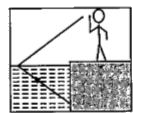
But due to negative refraction, he will be able to see it since the refracted ray now reaches his eye.
A ray in incident on normal glass and. "Inegative glass" at an angle 60∘. If the magnitude of angle of refraction in normal glass is 45∘ then, what will be the magnitude of angle of refraction in the "negative glass"?ALess than 45∘BMore than 45∘C45∘DUnpredictableNegative Refractive Index:
One of the most fundamental phenomena in optics is refraction. When a beam of light crosses the interface between two different materials, its path is altered depending on the difference in the refractive indices of the materials. The greater the difference, the greater the refraction of the beam. For all known naturally occurring materials the refractive index assumes only positive values. But does this have to be the case?
In 1967, Soviet physicist Victor Veselago hypothesized that a material with a negative refractive index could exist without violating any of the laws of physics.
Veselago predicted that this remarkable material would exhibit a wide variety of new optical phenomena. However, until recently no one had found such a material and Veselago's ideas had remained untested. Recently, meta-material samples are being tested for negative refractive index. But the experiments show significant losses and this could be an intrinsic property of negative index materials.
Snell's law is satisfied for the material having a negative refractive index, but the direction of the refracted light ray is 'mirror-imaged about the normal to the surface.

There will be an interesting difference in image formation if a vessel is filled with "negative water" having refractive index - 1.33 instead of regular water having refractive index 1.33.
Say, there is a fish in a vessel filled with negative water. The position of the fish is such that the observer cannot see it due to normal refraction since the refracted ray does not reach to his eye.

But due to negative refraction, he will be able to see it since the refracted ray now reaches his eye.
When the angle of incidence will be equal to angle of refraction for material having negative refraction index?AWhen angle of incidence = 90∘BWhen angle of incidence = 0∘CIt will vary from material to materialDIt is never possible
Two friends A and B are standing a distance x apart in an open field and wind is blowing from A to B.A beats a drum and B hears the sound t1 timed after he sees the event. A and B interchange their positions and the experiment is repeated. This time B hears the drum t2 time after he sees the event. Suppose A and B in the previous problem change their positions in such a way that the line joining them becomes perpendicular to the direction of wind while maintaining the separation x. What will be the time lag B finds betweenseeing and hearing the drum beating by A?
View SolutionDirections: Study the following information carefully and answer the question given below:
K, L, M, P, Q, R, S and T are sitting around a square table in such a way that four of them sit at four corners of the square while four sit in the middle of each of the four sides. The ones who sit at the four comers face outside while those 'who sit in the middle of the sides face the centre of the .table.
P sits thirds to the right of S. S faces the centre. Q sits third to the left of M. M does not sit in the middle of the sides. Only one person sits between Q and R. R is not an immediate neighbour of M. T faces the centre. K is not an immediate neighbour of R.
What is position of M with respect to L?
1) Third to the right
2) M and L sit diagonally opposite to each other
3) Second to the right
4) Second to the left
5) Fifth to the right
View SolutionNegative Refractive Index:
One of the most fundamental phenomena in optics is refraction. When a beam of light crosses the interface between two different materials, its path is altered depending on the difference in the refractive indices of the materials. The greater the difference, the greater the refraction of the beam. For all known naturally occurring materials the refractive index assumes only positive values. But does this have to be the case?
In 1967, Soviet physicist Victor Veselago hypothesized that a material with a negative refractive index could exist without violating any of the laws of physics.
Veselago predicted that this remarkable material would exhibit a wide variety of new optical phenomena. However, until recently no one had found such a material and Veselago's ideas had remained untested. Recently, meta-material samples are being tested for negative refractive index. But the experiments show significant losses and this could be an intrinsic property of negative index materials.
Snell's law is satisfied for the material having a negative refractive index, but the direction of the refracted light ray is 'mirror-imaged about the normal to the surface.
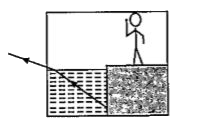
There will be an interesting difference in image formation if a vessel is filled with "negative water" having refractive index - 1.33 instead of regular water having refractive index 1.33.
Say, there is a fish in a vessel filled with negative water. The position of the fish is such that the observer cannot see it due to normal refraction since the refracted ray does not reach to his eye.
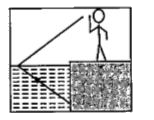
But due to negative refraction, he will be able to see it since the refracted ray now reaches his eye.
Is Snell's law applicable for negative refraction ?
View SolutionNegative Refractive Index:
One of the most fundamental phenomena in optics is refraction. When a beam of light crosses the interface between two different materials, its path is altered depending on the difference in the refractive indices of the materials. The greater the difference, the greater the refraction of the beam. For all known naturally occurring materials the refractive index assumes only positive values. But does this have to be the case?
In 1967, Soviet physicist Victor Veselago hypothesized that a material with a negative refractive index could exist without violating any of the laws of physics.
Veselago predicted that this remarkable material would exhibit a wide variety of new optical phenomena. However, until recently no one had found such a material and Veselago's ideas had remained untested. Recently, meta-material samples are being tested for negative refractive index. But the experiments show significant losses and this could be an intrinsic property of negative index materials.
Snell's law is satisfied for the material having a negative refractive index, but the direction of the refracted light ray is 'mirror-imaged about the normal to the surface.

There will be an interesting difference in image formation if a vessel is filled with "negative water" having refractive index - 1.33 instead of regular water having refractive index 1.33.
Say, there is a fish in a vessel filled with negative water. The position of the fish is such that the observer cannot see it due to normal refraction since the refracted ray does not reach to his eye.
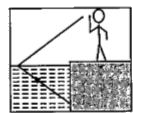
But due to negative refraction, he will be able to see it since the refracted ray now reaches his eye.
Who hypothesized that a material may have negative refractive index?
View SolutionNegative Refractive Index:
One of the most fundamental phenomena in optics is refraction. When a beam of light crosses the interface between two different materials, its path is altered depending on the difference in the refractive indices of the materials. The greater the difference, the greater the refraction of the beam. For all known naturally occurring materials the refractive index assumes only positive values. But does this have to be the case?
In 1967, Soviet physicist Victor Veselago hypothesized that a material with a negative refractive index could exist without violating any of the laws of physics.
Veselago predicted that this remarkable material would exhibit a wide variety of new optical phenomena. However, until recently no one had found such a material and Veselago's ideas had remained untested. Recently, meta-material samples are being tested for negative refractive index. But the experiments show significant losses and this could be an intrinsic property of negative index materials.
Snell's law is satisfied for the material having a negative refractive index, but the direction of the refracted light ray is 'mirror-imaged about the normal to the surface.
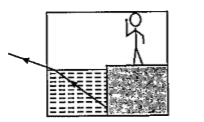
There will be an interesting difference in image formation if a vessel is filled with "negative water" having refractive index - 1.33 instead of regular water having refractive index 1.33.
Say, there is a fish in a vessel filled with negative water. The position of the fish is such that the observer cannot see it due to normal refraction since the refracted ray does not reach to his eye.
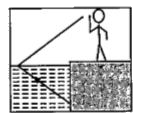
But due to negative refraction, he will be able to see it since the refracted ray now reaches his eye.
Which of the following is the intrinsic property of negative-index materials?
View Solution
